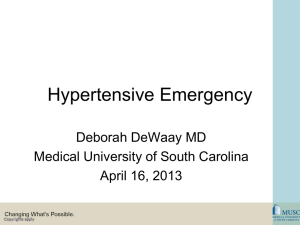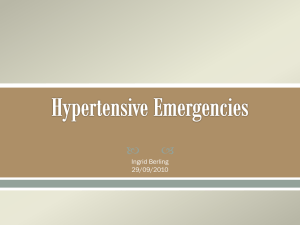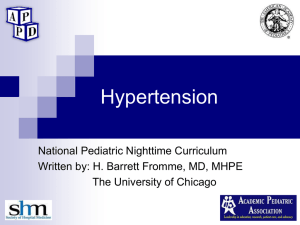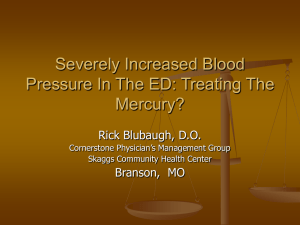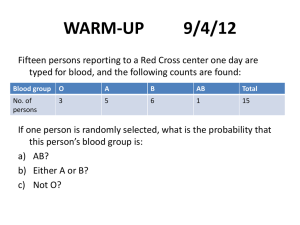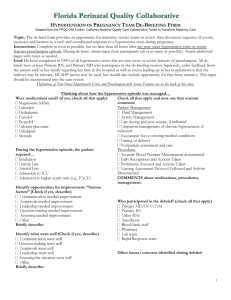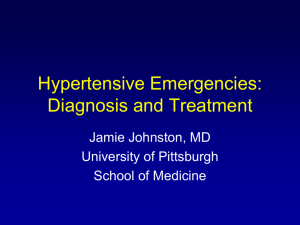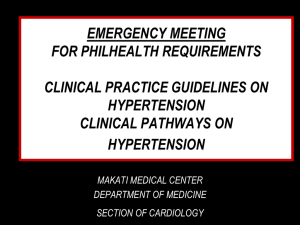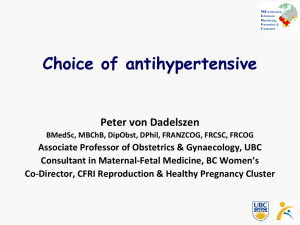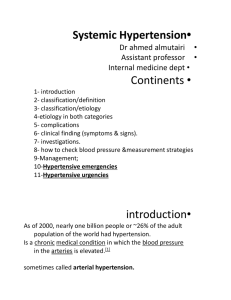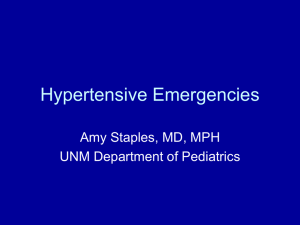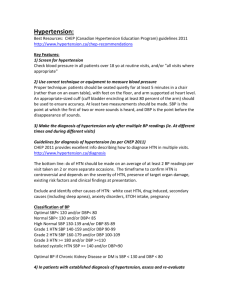Acute Hypertension
advertisement
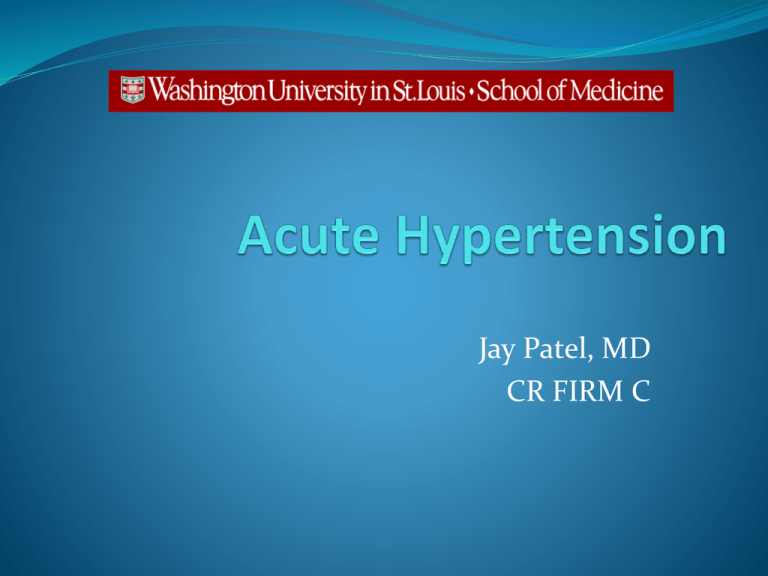
Jay Patel, MD CR FIRM C Initial Evaluation What are the vitals? EKG Is this new or old? What has the rate of increase been? Is the patient mentating well? Are there signs of acute end-organ damage? Acute Hypertension Is it urgent or emergent? Urgent SBP >180 or DBP >120 Emergent Urgent + End-organ damage End-organ damage Cardiac: pulmonary edema, ACS, aortic dissection Renal: ARF, proteinuria, hematuria ATN Neuro: cerebral edema, CVA, TIA, ICH Many patients will have headache from hypertensive urgency but no other end organ damage. Ophtho: retinal hemorrhage/exudate, papilledema Acute Hypertension Presentations c/w hypertensive emergency: BP >180/100 AND Encephalopathy Dyspnea Chest pain Things Not to miss… Aortic Dissection Intracranial Bleeding Acute Coronary Syndromes Treatment: Hypertensive urgency Titrate up current medications, Q2H BP checks until <160/100 Add rapid onset/rapid offset oral medications to assess response Captopril: ~6.25-12.5mg Clonidine: ~0.2mg In this situation, try to avoid starting IV drips DO NOT USE HYDRALAZINE The goal is BP <160/100 in HOURS to DAYS Physiology: Hypertensive Emergency As blood pressure rises, arterial/arteriolar vasoconstriction occurs (autoregulation) to protect distal arterioles and maintain perfusion. With increasing blood pressure, autoregulation fails. The vascular endothelium loses integrity, and plasma contents enter the vessel wall. The vascular lumen is narrowed or obliterated, leading to ischemia. Treatment: Hypertensive Emergency Use IV bolus/drips to rapidly correct blood pressure Labetalol: 20mg initially, with repeat boluses (20-80mg) Q10min to total 300mg. Then gtt 0.5-2mg/min. Nitroprusside: 0.25-0.5mcg/min, titrate to goal BP with max rate 10mcg/min. Nitroglycerin: 5-100+mcg/min. Nicardipine: 5-15mg/hr. DO NOT USE HYDRALAZINE The goal is to decrease diastolic BP to 100-105mmHg with initial MAP decrease no greater than 25% in MINUTES to HOURS Nitrates Nitroglycerin Good for pulmonary edema and angina Preload/afterload reduction Tachyphylaxis occurs quickly Need high doses to reduce BP Will cause headache Nitroprusside Do not use in renal failure, due to cyanide metabolite Beta-blockers Labetolol Good for rapid onset of action (<5 minutes) Limited by bradycardia, can cause heart block Do not use in acute CHF Caution with underlying COPD/Asthma Calcium channel blockers Nicardipine Effective, use if contraindications to other agents Do not use in acute CHF, ACS Case 1 J.B. is a 55 y.o. AAM with hx of HTN, GERD, in the ER with chest pain and dyspnea The patient looks extremely uncomfortable but is able to answer questions appropriately… pain is 10/10 and ‘going right through’ his chest 195/120 105 24 96% RA What is your initial DDx? Case 1 Get BP in BOTH arms R 190/100, L 165/95 What therapy do you start empirically? What imaging/labs do you want? Case 1 Case 1 Case 1 Therapy: IV labetalol and IV nitrate Goal SBP <100, goal HR 60s DO NOT USE HYDRALAZINE Imaging: Dissection protocol CT TEE Labs: BMP, CBC, troponin, CK-MB, type/cross, PT, PTT Consult vascular surgery CT Aortic Dissection Types: Type A/Proximal ascending aorta Type B/Distal descending aorta only Complications: Valvular insufficiency CVA/TIA Tamponade Renal/bowel ischemia MI Case 2 F.M. is a 84 y.o AAF with hx of HTN, DM2, CHF, and CKD in the ER with chest pain and dyspnea She missed several doses of medication (BB, ACE-I, CCB, ASA) while out of town at a Ham Eating Festival 205/115 105 24 87% RA What is your initial DDx? Case 2 Get BP in BOTH arms R 205/110 L 210/105 What therapy do you start empirically? What imaging/labs do you want? Case 2 Case 2 Case 2 Therapy: IV furosemide, IV nitroglycerin, O2 Goal: improvement in dyspnea, O2 requirement Avoid beta-blocker in this patient DO NOT USE HYDRALAZINE Imaging: CXR Labs: BMP, CBC, troponin, CK-MB, BNP Case 3 A.C. is a 76 y.o WF with history of HTN, DM2, CAD admitted for hypertension and headache Initial workup including EKG, Trop, BMP, and CXR are unremarkable… The patient’s HTN remains difficult to control with oral agents. On HD#1, you are called to see patient for “garbled speech” What is your initial DDx? Case 3 BP 220/135 in both arms, HR 90, SaO2/RR stable Exam notable for inability to follow commands and agitation, no cranial nerve deficits, moving all four extremities What imaging/labs do you want? Case 3 Case 3 Case 3 Therapy: IV labetalol or nicardipine Goal: improvement in mental status, airway protection, seizure precautions DO NOT USE HYDRALAZINE Imaging: Brain MRI to follow up Labs: BMP, CBC, troponin, CK-MB RPLE/RPLS/PRES Results from disordered cerebral autoregulation, endothelial dysfunction, and ischemia Hypertensive encephalopathy, eclampsia, and immunosuppressive drugs (esp. cyclosporine) are associated conditions Therapy involves control of blood pressure, removal of offending agents (delivery, cyclosporine), and management of seizures if they occur CVA/Hemorrhage Ischemic CVA: Do not treat HTN unless BP >220/120 OR the patient has concomitant ACS, CHF, aortic dissection, eclampsia IV labetolol is drug of choice If lytics are being used, BP has to be <180/105 and maintained there for 24 hours post lytics Intracranial/subarachnoid hemorrhage Goal is SBP <200 or MAP <150, use IV labetalol Call neurosurgery for ICP monitoring Case 4 D.Y. is a 52 y.o male with history of HTN, DM2, admitted for community acquired pneumonia You are on night float and get a call that the patient’s BP is 175/95. How do you approach this? Case 4 A) Review the patient’s medication list B) Review the patient’s BP trends C) A and B D) Give 5mg IV hydralazine Case 4 Inpatient hypertension that is not urgent or emergent should be treated like outpatient hypertension. Add appropriate anti-hypertensives as you would in clinic and don’t aggressively add multiple agents. Remember, amlodipine, lisinopril, etc. often take several days to reach their effect. Summary Any patient with hypertension and chest pain or dyspnea needs blood pressure measured BY YOU in both arms. Evaluate the hypertensive patient for signs of endorgan damage with EKG, troponin, and neurologic exam. Hypertensive urgency: Oral medications. Hypertensive emergency: IV medications and consider ICU transfer. Inpatient hypertension: Treat like you would in clinic. Why Hydralazine is Terrible Reflex tachycardia can increase myocardial oxygen demand and cause ischemia in patients with CAD. Unpredictable hypotension can ensue, especially in patient with pulmonary hypertension. Patient with low GFR may have several dips in blood pressure, resulting in drug stacking—hydralazine is renally cleared. Drug-induced lupus and neuropathy are long-term risks, but those with HLA-DR4 genotype may be at risk with IV dosing.
